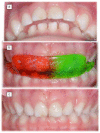Temporomandibular Joint and Otitis Media: A Narrative Review of Implications in Etiopathogenesis and Treatment
- PMID: 36557008
- PMCID: PMC9786198
- DOI: 10.3390/medicina58121806
Temporomandibular Joint and Otitis Media: A Narrative Review of Implications in Etiopathogenesis and Treatment
Abstract
Otitis media (OM) and its recurring (rAOM), effusive (OME), and chronic forms, represent a frequent clinical challenge. The middle ear, the mandible, and the temporomandibular joint (TMJ) share several embryological and anatomical connections. Despite that, the role of mandibular malposition and TMJ dysfunction is frequently overlooked in the management of otitis media. In this narrative review, we present current evidence supporting the etiopathogenetic role of a dysfunctional stomatognathic system in the onset of OM and the effectiveness of orthognathic treatment in preventing rAOM and OME. In particular, a focus on the influence of TMJ on Eustachian tube function is provided.
Keywords: OSAS; gnathology; malocclusion; oral appliance; otitis media; otitis media with effusion; recurrent acute otitis media; temporomandibular joint; temporomandibular joint dysfunction.
Conflict of interest statement
The authors declare no conflict of interest.
Figures




Similar articles
-
The relationship between craniomandibular disorders and otitis media in children.Cranio. 1991 Apr;9(2):169-73. doi: 10.1080/08869634.1991.11678364. Cranio. 1991. PMID: 1802427
-
Clinical characteristics of atelectatic eardrums and adhesive otitis media in children.Int J Pediatr Otorhinolaryngol. 2022 Aug;159:111188. doi: 10.1016/j.ijporl.2022.111188. Epub 2022 May 26. Int J Pediatr Otorhinolaryngol. 2022. PMID: 35653949
-
Gnatological considerations on "Pediatric temporomandibular joint ankulosis and arthritis: Forgotten complications of acute otitis media".Am J Otolaryngol. 2023 Mar-Apr;44(2):103727. doi: 10.1016/j.amjoto.2022.103727. Epub 2022 Dec 10. Am J Otolaryngol. 2023. PMID: 36528973 No abstract available.
-
Pediatric temporomandibular joint ankylosis and arthritis: Forgotten complications of acute otitis media.Am J Otolaryngol. 2022 Sep-Oct;43(5):103599. doi: 10.1016/j.amjoto.2022.103599. Epub 2022 Aug 12. Am J Otolaryngol. 2022. PMID: 35988366 Review.
-
"Multidisciplinary management of post- infective osteoarthritis and secondary condylar resorption of temporomandibular joint: a case report in a 9 years-old female patient and a review of literature".Ital J Pediatr. 2022 May 3;48(1):62. doi: 10.1186/s13052-022-01255-0. Ital J Pediatr. 2022. PMID: 35505365 Free PMC article. Review.
Cited by
-
Is there any correlation between otitis media and dental malocclusion in children? A systematic review.Eur Arch Paediatr Dent. 2023 Aug;24(4):441-449. doi: 10.1007/s40368-023-00807-0. Epub 2023 Jun 20. Eur Arch Paediatr Dent. 2023. PMID: 37338742 Free PMC article.
-
Resolution of Otitis Media with Effusion in Adults after a Three-Day Course of Treatment with a Manosonic Nebulizer-A Pilot Study.Medicina (Kaunas). 2023 Jan 19;59(2):201. doi: 10.3390/medicina59020201. Medicina (Kaunas). 2023. PMID: 36837402 Free PMC article. Clinical Trial.
-
Future Perspectives in the Management of Otitis Media.Medicina (Kaunas). 2023 Aug 26;59(9):1553. doi: 10.3390/medicina59091553. Medicina (Kaunas). 2023. PMID: 37763672 Free PMC article.
References
Publication types
MeSH terms
LinkOut - more resources
Full Text Sources
Medical

